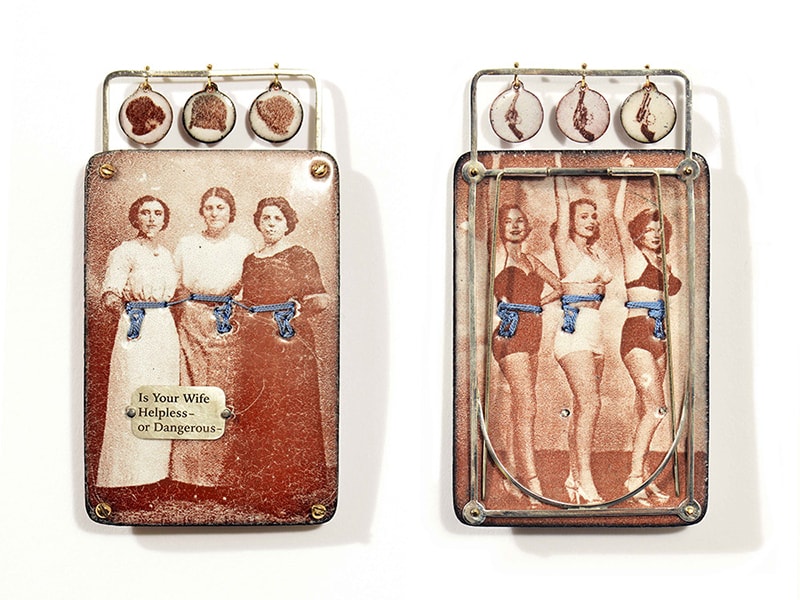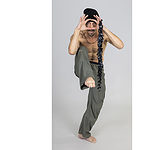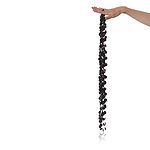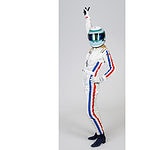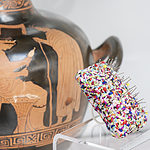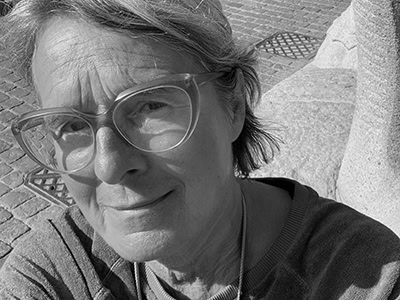Werke und Tage
March 10–August 30, 2020
Staatliche Antikensammlung, Munich, Germany
Danish Jewellery Box
March 13–August 1, 2021
Museum für Angewandte Kunst Köln, Cologne, Germany
Since 1974, regularly changing committees in the Danish Arts Foundation (founded in 1964) have acquired artworks from all artistic disciplines, including applied arts. Its national jewelry collection (comprising about 350 pieces) is part of this large national collection of art and crafts. Because it is a national art collection, paid for with taxpayer money, the collection is open for loans. The intention is to promote art and artists in Denmark by bringing the pieces into public environments (schools, offices, etc.) where people will encounter the artworks in their everyday surroundings. In 2007 a new idea was devised to also make the jewelry collection accessible to people through a lending scheme. Besides this, the jewelry collection has been on permanent view at the Designmuseum Denmark, Museum Koldinghus for two years, and will be in the future at the new Kolding Museum as well. Every five years the contract has to be renewed, and eventually the collection will be hosted in a different museum in another part of the country. The recent exhibitions Werke und Tage and Danish Jewellery Box saw the most open and democratic public jewelry collection in the world taking a trip to Germany in honor of the Danish-German Cultural Year of Friendship 2020.
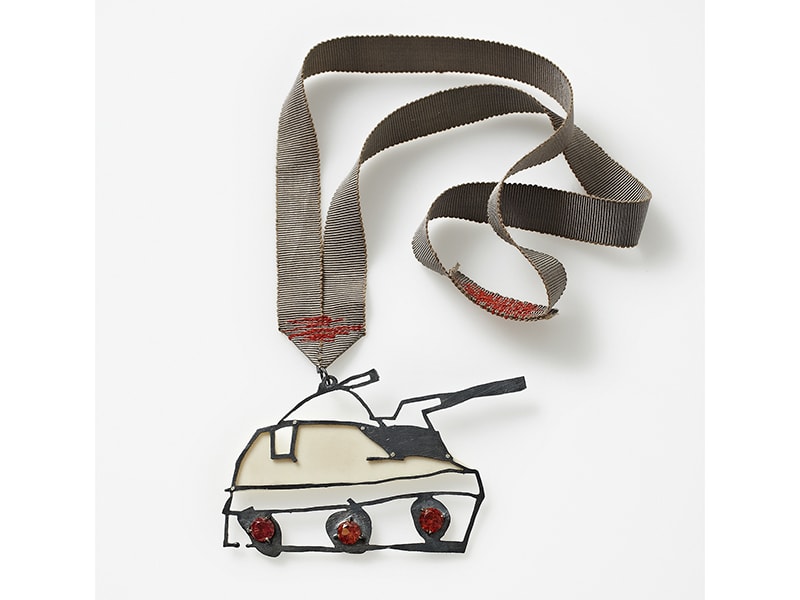
In November 2018, the Danish Arts Foundation and curator Mette Saabye embarked on a journey that took more time than anyone could ever have foreseen. To mark the Danish-German Cultural Year of Friendship 2020, and on behalf of the Danish Arts Foundation, Saabye was invited to develop an idea to exhibit the jewelry collection of the Danish Arts Foundation in collaboration with German museums. Saabye is a goldsmith and jewelry artist from Copenhagen. She was a member of the Danish Arts Foundation for two years, 2014–2015, and has been involved with previous presentations and events related to the collection. Therefore, she knows the collection very well. After exploring several German venues, she was invited to enter into a co-curatorial collaboration with the Staatliche Antikensammlung, in Munich, and the Museum für Angewandte Kunst Köln (Museum of Applied Arts in Cologne, or MAKK), two museums that would offer the best possibility to create different dialogues with Danish contemporary jewelry.
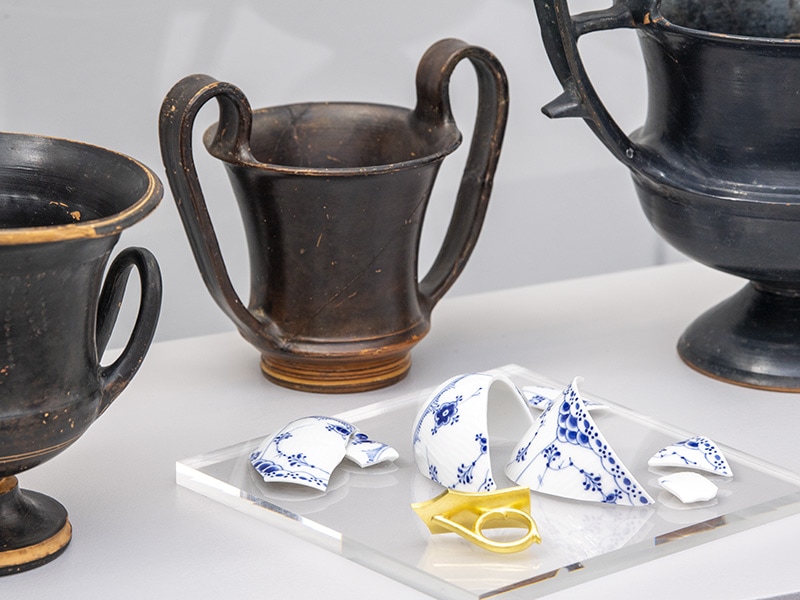
Florian Knauß, senior collection director of Antikensammlung und Glyptothek, München, was very helpful and collaborative, even allowing the installation of contemporary jewelry amidst the archaeological collection—something that has been done earlier only occasionally[1]—and even rearranging the permanent display because of the exhibition. For Petra Hesse, the MAKK’s director, the exhibition was an excellent reason to invite local people to be photographed wearing a piece of jewelry from the exhibition.
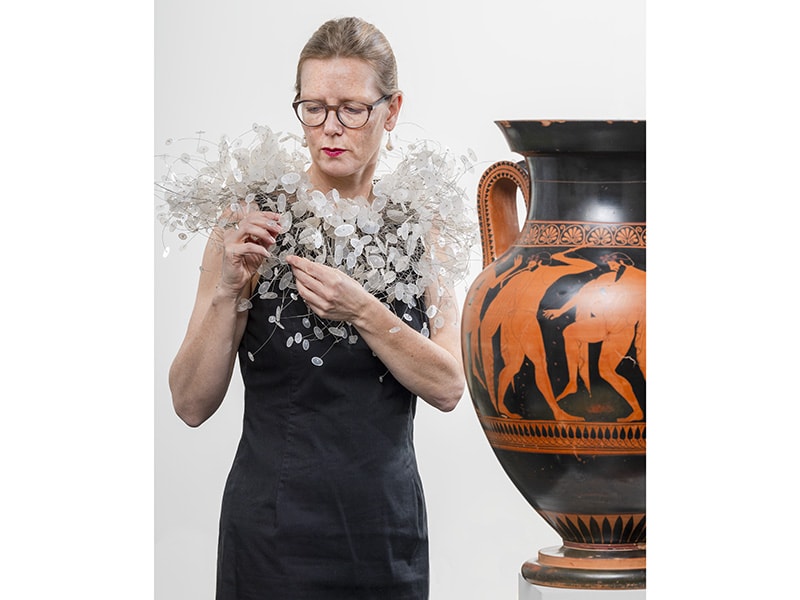
The organization of the exhibitions was well prepared, with Werke und Tage (Works and Days), the exhibition in Munich, planned to open during the Munich jewelry week of 2020, and the MAKK opening planned for November. However, the pandemic threw a wrench in the works. Fortunately, I was able to visit Werke und Tage the day before the Antikensammlung closed abruptly. In May the museum opened again until August 2020 but the exhibition missed out on the large numbers of jewelry enthusiasts from around the world who usually congregate during Munich Jewellery Week in March.
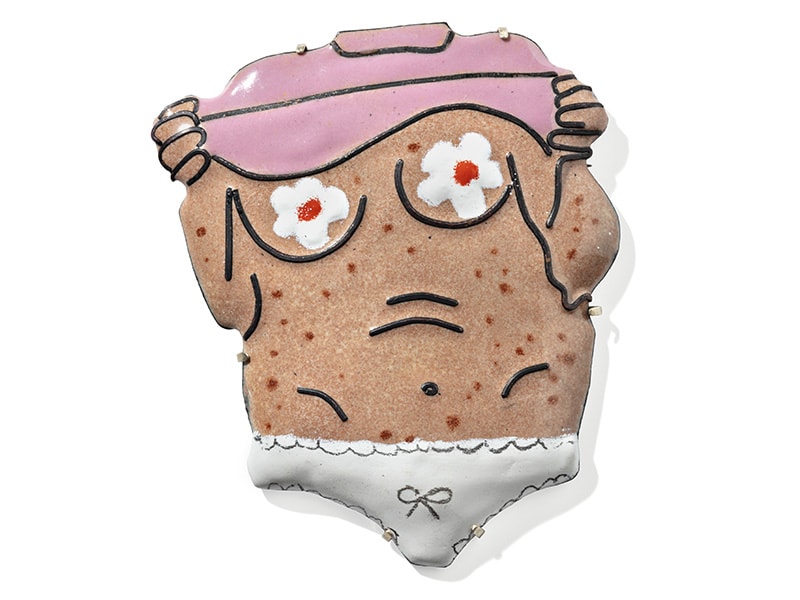
The other opening, in Cologne, forecast for November, was postponed several times. Finally, the exhibition—now with a new name, Danish Jewellery Box—opened online on March 12, 2021. In her opening speech, museum director Hesse showed some of the life-size photographs of Cologne citizens wearing jewelry that are an integral part of the exhibition. She hopes this introduction to contemporary jewelry could be a stepping stone to starting a jewelry-lending collection in the museum sometime. The exhibition opened to the public June 1–August 31, 2021. Even though MAKK is open for registered visitors, I have not been able to go there because of coronavirus restrictions for visitors from my country to Germany. The story of the circulating collection, the quality of the Munich exhibition, and that of the publications of both museums, together with the sheer stamina of all the people engaged in this exhibition, were good reasons to write this article.
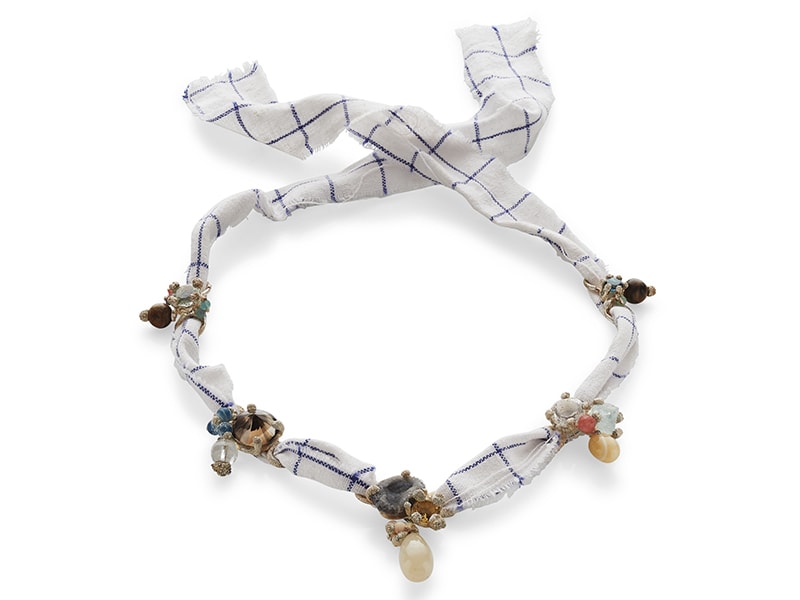
The jewelry collection is not a “shelf collection” at all, by which I mean that it is not stored in a secured, climatized, and locked storeroom, a fate many museum jewelry collections unfortunately suffer from. Instead, it circulates through the country, reaching even places in the periphery, while any Danish citizen who plays an active role at an official event can borrow a piece of jewelry from the collection to wear to the function.[2] On top of this, (parts of) the collection travel abroad, accompanying state visits to places such as Beijing, Seoul, Houston, and Mexico—a kind of soft diplomacy to show what democracy means in Denmark.[3] This managing of a public collection is the opposite of that of the average museum, where white gloves and security reports and checks are the ruling standard. I don’t think I’m exaggerating when I call this the most open and democratic public jewelry collection in the world.

Managing a lending collection of jewelry is based on mutual trust and understanding, from the state, the museum curators, and those who borrow. Although people may borrow the piece without paying any costs and keep it for up to three months, there are some rules. For instance, the borrower should wear the piece in public, at official openings, celebrations, and other events. In other words, the borrower commits to being an ambassador of the piece and for the Danish Arts Foundation (and its arts policy). This also means that the borrower needs to know something about the jewelry to be able to answer people who ask questions about it. Furthermore, the borrower should write down her experiences—how it felt to wear a conversation piece, to get reactions and questions—and a photo is requested of the piece in use. The Art Foundation asks for a big commitment, and in reality not every borrower does exactly as requested. But many people use social media to post about the piece, the event, and the collection. The reports are collected by the host museum, resulting in a logbook for every piece in the collection.

It’s remarkable that the Danish Arts Foundation considers the national collection of jewelry a living collection of wearable art pieces that are expected to move in society, among people, and to acquire and collect new stories and memories. The state-owned jewelry distinguishes the wearer from other people, and at the same time the jewelry, although not emotionally linked to one specific person, functions as a “container” for stories, emotions, memories, encounters, and events. Where else we can find such understanding of the essence of jewelry among its institutional collectors?
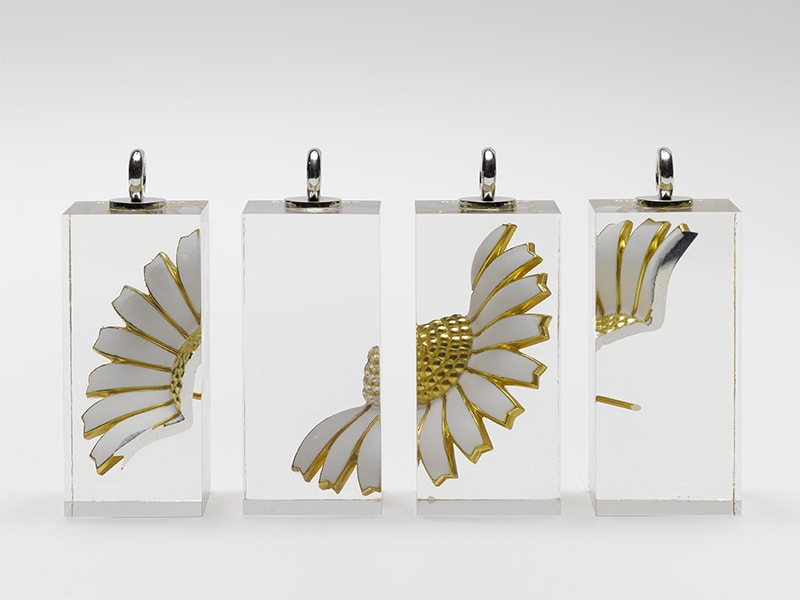
Exhibition curator Mette Saabye didn’t want to impose a sharply defined exhibition concept on the partners in Germany. Instead, she offered a fluid idea with multiple possibilities for dialogue and exchange, in line with the celebration of a friendship bond. The selection of Danish pieces for the exhibition in Munich was made by Saabye and the museum director Florian Knauß in equal quantities. It’s clear that this way of working promotes the dialogue. In Cologne, too, the selection was made together with museum director Petra Hesse, who added a considerable number of pieces in the MAKK’s collection of contemporary jewelry to the mix. For reasons of coherence, Saabye took the liberty of inviting some artists who are not represented in the national collection. The different themes in Munich and Cologne are the result of the dialogue between the Danish and German curators.
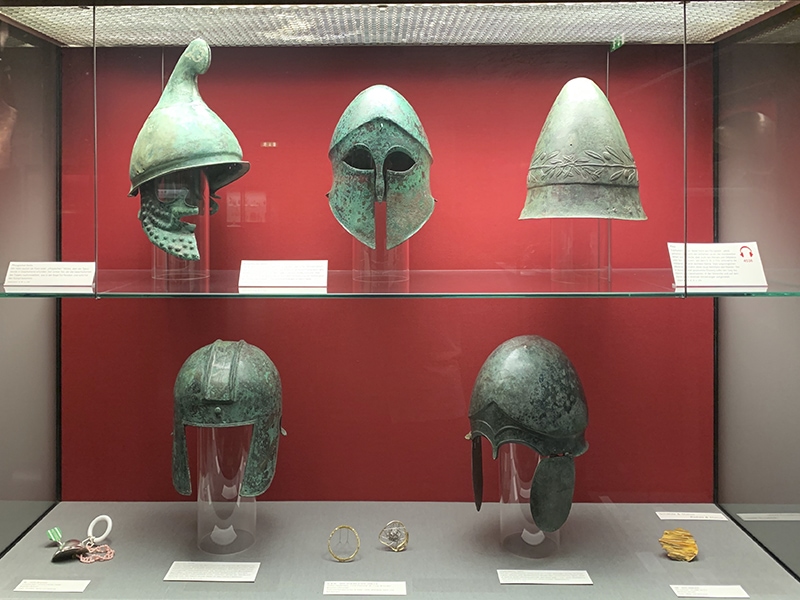
The exhibition in Munich stressed the fact that not much has changed in the activity and tools used by craftspeople since antiquity. What has changed is society, and therefore our guiding principles and reasons for wearing jewelry. Yet there are themes and facets of daily life that play an important role in ancient crafts as well as today’s. In searching for these themes, the curators found striking similarities and created interesting juxtapositions, for instance in the case of decorations and rhythms, and when dealing with themes such as the position of women, love, war, and death.
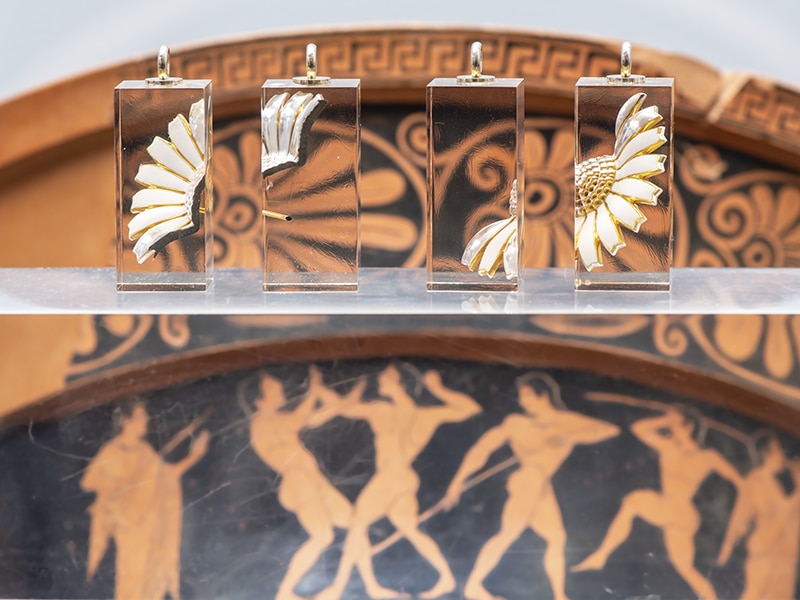
Saabye was extremely happy with the Antikensammlung’s approach because she has an affinity with antiquity and antique jewelry as part of the history of the goldsmith. But what pleased her most is the unpredictability of exhibiting contemporary jewelry in an antique context. In her own words: “When you mix values, you gain so much more.”
That becomes clear when you examine the theme “Power & Women”—one of 12—in the Werke und Tage exhibition. This section includes an amazing Greek hydria (vase) with a beautiful depiction of Amazons (powerful and courageous female warriors and hunters who had a closed female society) picking up their armor for a fight. It’s combined with some outstanding contemporary jewels, such as Nanna Obel’s Is Your Wife Helpless – or Dangerous, and Kim Buck’s segmented Daisy pendants. The jewelry’s title plays on names: Daisy is the Danish queen Marghrete’s nickname, but it also alludes to the old game of plucking the daisy (he loves me, he loves me not). The viewer is confronted with the topic of female stereotypes, whore or muse, subordinate or powerful, all of which are still flourishing.
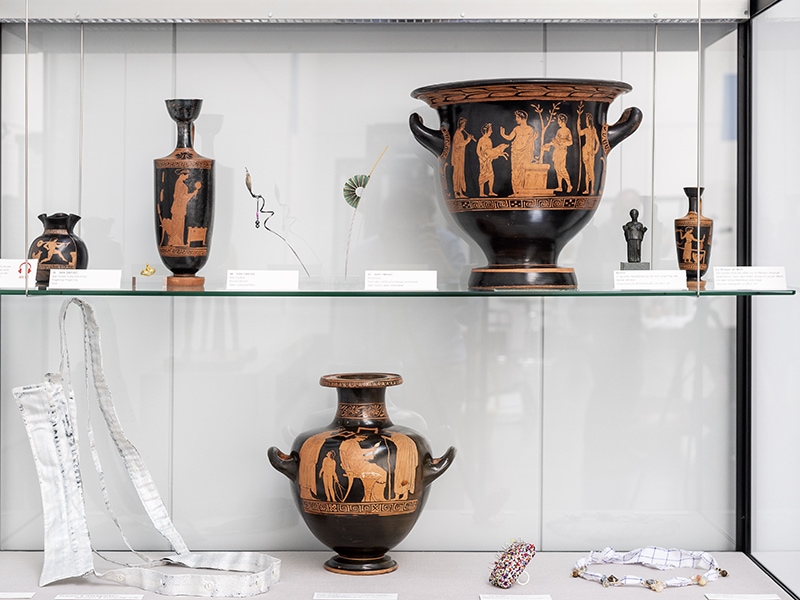
The theme “Women & Everyday Life” involves some wonderful examples of antique vases that show the main tasks of women in Greek society then: caring for the house and family, spinning, and weaving. Apart from taking care of the family tombs, a respectable Greek woman did not go outside. The vases are confronted with outstanding pieces such as Helen Clara Hemsley’s Found on the Floor ring, made of roughly stitched thick cotton thread on a cushion with a multitude of pins inserted into it, or the necklace by Pernille Mouritzen called Daily Patterns, made of a combination of irregular sets of precious stones set in silver linked with checkered tea towel fragments roughly torn into strips.
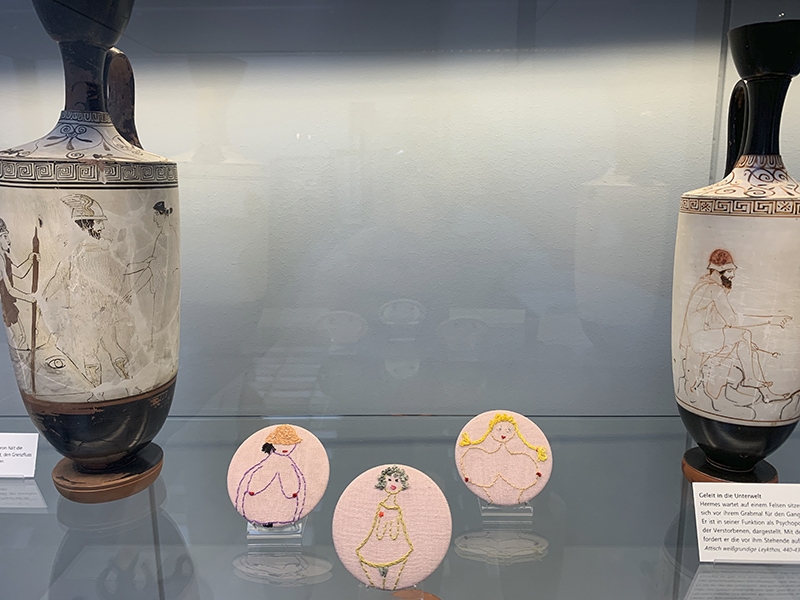
Both pieces reflect on a typical female skill in the household: needlework. The three embroidered brooches by Jytte Løppenthin, with cartoonish images of naked women showing their breasts sketched in stitched line drawings, seem more like visual antitheses to the delicate outline drawings of women and gods on the white-grounded Attic lekythoi next to it. Lekythoi vases were associated with funeral rites, and often depict women. These vases held perfumed oil, which was used to lubricate a woman’s body before marriage. They were also placed in the graves of unmarried women. The play of life in front of the rite of death is displayed in this showcase.
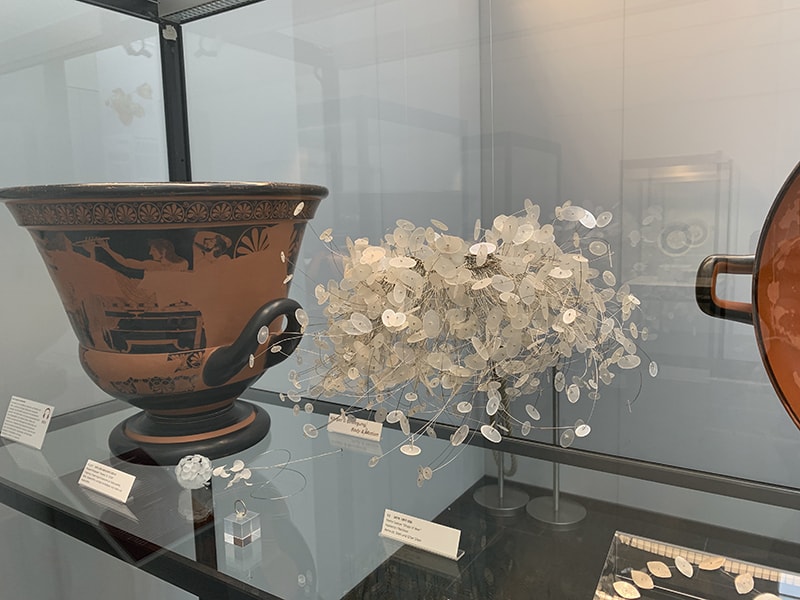
In the theme “Body and Motion,” Saabye’s necklace Drops of Dew, consisting of innumerous small round slices of mother-of-pearl in different sizes attached to thin steel threads, was presented together with Dionysian vases depicting ecstatic drinking sessions. You wonder what Saabye’s necklace has to do with the scenes on the antique vases until you realize that wearing such a necklace, with its constant pulse of moving parts, might evoke a feeling of ecstasy and whirlwind.

At the same time the visitor can look for formal similarities, for instance in the section “Symmetry & Rhythm,” where an impressively big 8th-century BC amphora from the so-called Geometric period is shown in combination with abstract contemporary jewelry with linear and repetitive elements, for instance by Karen Ihle and Jens Eliasen.
Danish Jewellery Box, the exhibition in Cologne, had a rather formal atmosphere, with all the jewelry neatly arranged in showcases according to 13 themes that are rather obvious, such as “Body & Jewellery,” “Tradition & Innovation,” “Alternative Materials,” “Form & Function,” “Humour & Sarcasm,” “Decoration & Concept.” However, the life-size portrait photos installed along the walls of the exhibition are quite daring. They portray citizens of Cologne from foot to crown—an administrator, an opera singer, a bookseller, a piano teacher, and Gabriele Spangenberg, a racer of historic sports cars. Portrayed in her racing suit with a closed helmet on her head, Spangenberg has a striking appearance, but it takes some time to discover Pernille Mouritzen’s Bush-Jet necklace hanging from her neck. In this context, the brass plane cut in a sketched style with a speech bubble containing the words HA HA HA HA HA HA turns the car racer into a spacewoman, also explaining the triumphant upward gesture of her right arm. The necklace is part of the theme “Illusion & Reality.” In Munich the piece was part of the theme “Love & War” and was exhibited in a showcase with imposing Greek vases. Interestingly, these 6th-century BC vases depicting scenes from the Trojan war or preparations for a contest strengthened the message of the 21st-century jewelry. They could be interpreted as a comment on the Iraq war started by president George Bush in 2002 that lasted until the end of 2011. The same piece of jewelry in different contexts can hold different meanings, similar to what happens when a piece of jewelry circulates on the body of a wearer in a crowd. Then the personality and identity of the wearer mingle with the views and interpretations of the other people around them.
I truly believe playing with jewelry (and art in general) is the best way to get a deeper understanding of it. Trying out jewelry in different contexts, finding different meanings, is enriching, but in general it’s the privilege of private owners of jewelry. Museums are often at odds with jewelry. Much jewelry, historical and contemporary, is stored away in depots or sentenced to a static stay in a permanent display. Of course, the museum also offers advantages: the jewelry is kept safe, documented and restored if necessary, and when on display visitors can see it and learn more about jewelry. But actually, jewelry needs life, adventure, interaction, and movement to come fully into its own. And that’s exactly what the Danish jewelry intruders accomplished in Germany. The Staatliche Antikensammlung, in Munich, and the MAKK, in Cologne, had to look at their own collections of, respectively, antique art or contemporary international jewelry with different eyes. It resulted in two entirely different exhibitions based on the same collection of jewelry funded by public Danish money. And it shows jewelry at work in the best way.
Note: All illustrated objects are part of the Danish Arts Foundation, unless otherwise mentioned.
[1] Bernhard Schobinger exhibition Feuer über Wasser, Museum Boijmans Van Beuningen, Rotterdam (1999–2000); and Peter Bauhuis exhibition Der Galliumhort von Obertraun, Archaeological Museum, Munich (2011).
[2] Since Koldinghus Museum has started hosting the collection, the number of loaners has increased from 25 per year to 80. The lending scheme is published on the Danish Art Foundation website. The complete collection has been displayed in the museum and is used in social media.
[3] This democratic perspective and open attitude, so manifest in the Danish arts sector, is in stark contrast with the Danish refugee policy, which was criticized internationally in 2016 because of the introduction of the “jewellery law.” This law allowed the confiscation of refugees’ valuables to cover the costs of their stay in Denmark. Fortunately, apart from a confiscated car and a substantial amount of money, no jewelry was ever confiscated.
